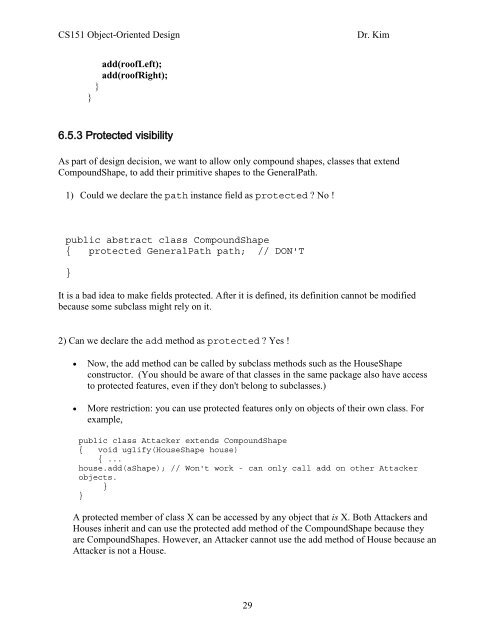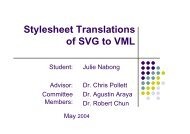Chapter 6: Inheritance and Abstract Classes Chapter Topics 6.1 ...
Chapter 6: Inheritance and Abstract Classes Chapter Topics 6.1 ...
Chapter 6: Inheritance and Abstract Classes Chapter Topics 6.1 ...
You also want an ePaper? Increase the reach of your titles
YUMPU automatically turns print PDFs into web optimized ePapers that Google loves.
CS151 Object-Oriented Design<br />
Dr. Kim<br />
add(roofLeft);<br />
add(roofRight);<br />
}<br />
}<br />
6.5.3 Protected visibility<br />
As part of design decision, we want to allow only compound shapes, classes that extend<br />
CompoundShape, to add their primitive shapes to the GeneralPath.<br />
1) Could we declare the path instance field as protected ? No !<br />
public abstract class CompoundShape<br />
{ protected GeneralPath path; // DON'T<br />
}<br />
It is a bad idea to make fields protected. After it is defined, its definition cannot be modified<br />
because some subclass might rely on it.<br />
2) Can we declare the add method as protected ? Yes !<br />
• Now, the add method can be called by subclass methods such as the HouseShape<br />
constructor. (You should be aware of that classes in the same package also have access<br />
to protected features, even if they don't belong to subclasses.)<br />
• More restriction: you can use protected features only on objects of their own class. For<br />
example,<br />
public class Attacker extends CompoundShape<br />
{ void uglify(HouseShape house)<br />
{ ...<br />
house.add(aShape); // Won't work - can only call add on other Attacker<br />
objects.<br />
}<br />
}<br />
A protected member of class X can be accessed by any object that is X. Both Attackers <strong>and</strong><br />
Houses inherit <strong>and</strong> can use the protected add method of the CompoundShape because they<br />
are CompoundShapes. However, an Attacker cannot use the add method of House because an<br />
Attacker is not a House.<br />
29




